Automatic Transaxle Controls
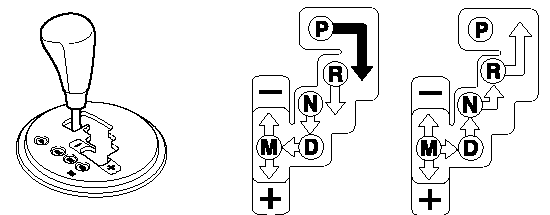
Various Lockouts:
 Indicates that you must
Indicates that you must
depress the brake pedal to shift (The ignition
switch must be in the ACC or ON position).
 Indicates the shift lever can
Indicates the shift lever can
be shifted freely into any position.
NOTE:
This Sport AT has an option that is not included in traditional automatic
transaxle - giving the driver
the option of selecting each gear instead of leaving it to the transaxle to
shift gears. Even if you
intend to use the automatic transaxle functions as a traditional automatic, you
should also be aware
that you can inadvertently shift into manual shift mode and an inappropriate
gear may be retained as
you change speeds. If you notice the engine speed going higher or hear the
engine racing, confirm
you have not accidentally slipped into manual shift mode.
Transaxle Ranges
The shift lever must be in P or N to operate the starter.
P (Park)
P locks the transaxle and prevents the front wheels from rotating.
WARNING:
Always set the shift lever to P and set
the parking brake:
Only setting the shift lever to the P
position without using the parking
brake to hold the vehicle is
dangerous. If P fails to hold, the
vehicle could move and cause an
accident.
CAUTION:
 Shifting into P, N or R while the
Shifting into P, N or R while the
vehicle is moving can damage
your transaxle.
 Shifting into a driving gear or
Shifting into a driving gear or
reverse when the engine is running
faster than idle can damage the
transaxle.
R (Reverse)
In position R, the vehicle moves only backward. You must be at a complete stop before shifting to or from R, except under rare circumstances as explained in Rocking the Vehicle.
N (Neutral)
In N, the wheels and transaxle are not locked. The vehicle will roll freely even on the slightest incline unless the parking brake or brakes are on.
WARNING:
If the engine is running faster than idle,
do not shift from N or P into a driving
gear:
It's dangerous to shift from N or P
into a driving gear when the engine
is running faster than idle. If this is
done, the vehicle could move
suddenly, causing an accident or
serious injury.
Do not shift into N when driving the
vehicle:
Shifting into N while driving is
dangerous. Engine braking cannot be
applied when decelerating which
could lead to an accident or serious
injury.
CAUTION:
Do not shift into N when driving the
vehicle. Doing so can cause transaxle
damage.
NOTE:
Apply the parking brake or depress the brake
pedal before moving the shift lever from N to
prevent the vehicle from moving unexpectedly.
D (Drive)
D is the normal driving position. From a stop, the transaxle will automatically shift through a 6-gear sequence.
M (Manual)
M is the manual shift mode position.
Gears can be shifted up or down by operating the shift lever.
Refer to Manual Shift Mode.
Active Adaptive Shift (AAS)
Active Adaptive Shift (AAS) automatically controls the transaxle shift points to best suit the road conditions and driver input. This optimizes engine performance and improves driving comfort. When cornering the vehicle, AAS mode will hold the transaxle in the gear the vehicle was in before entering the curve, allowing the vehicle to be accelerated from the same gear after exiting the curve.
If the driver accelerates rapidly, or accelerates and decelerates rapidly by operating the accelerator and brake pedal for a certain period of time while the selector lever is in the D position, AAS mode could activate. When this occurs, AAS mode will maintain the transaxle in the optimum gear and the driver may sense that the transaxle is not shifting, however this does not indicate an abnormality.
Shift-Lock System
The shift-lock system prevents shifting out of P unless the brake pedal is depressed.
To shift from P:
1. Depress and hold the brake pedal.
2. Start the engine.
3. Move the shift lever.
NOTE:
- When the ignition switch is in the LOCK
position, the shift lever cannot be shifted
from P.
- To be sure the vehicle is in park, the ignition key cannot be removed unless the shift lever is in P.
- (With Advanced Key).
The ignition switch cannot be turned from the ACC to the LOCK position when the shift lever is not in P.
Manual Shift Mode
This mode gives you the feel of driving a manual transaxle vehicle by operating the shift lever and allows you to control engine rpm and torque to the front wheels much like a manual transaxle when more control is desired.
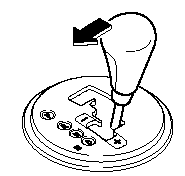
To change to manual shift mode, shift the lever from D to M.
To return to automatic shift mode, shift the lever from M to D.
NOTE:
If you change to manual shift mode when the
vehicle is stopped, the gear will shift to M1.
Indicators
Shift position indicator
In manual shift mode, the УMФ of the shift position indicator in the instrument panel illuminates.
Gear position indicator
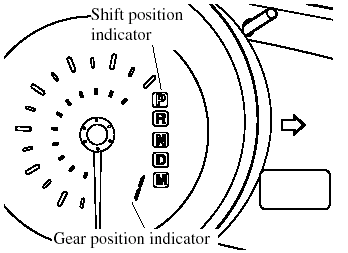
The numeral for the selected gear illuminates.
NOTE:
If the gears cannot be shifted down when
driving at higher speeds, the gear position
indicator will flash twice to signal that the
gears cannot be shifted down.
Shifting
Manually Shifting up
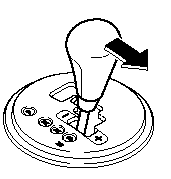
(M1→M2→M3→M4→M5→M6).
To shift up to a higher gear, tap the shift lever back (+) once.
NOTE:
- When driving slowly, the gears may not
shift up depending on vehicle speed.
- In manual shift mode, gears do not shift up automatically. Don't run the engine with the tachometer needle in the RED ZONE. If the tachometer needle enters the RED ZONE, you may feel engine-braking because the fuel delivery will be stopped to protect the engine. However, this does not indicate an abnormality.
- When depressing the accelerator fully, the transaxle will shift to a lower gear, depending on vehicle speed.
Manually Shifting down
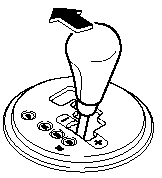
(M6→M5→M4→M3→M2→M1).
To shift down to a lower gear, tap the shift lever forward (-) once.
WARNING:
Do not use engine braking on slippery
road surfaces or at high speeds:
Shifting down while driving on wet,
snowy, or frozen roads, or while
driving at high speeds causes sudden
engine braking, which is dangerous.
The sudden change in tire speed could cause the tires to skid. This could lead to loss of vehicle control and an accident.
NOTE:
- When driving at high speeds, the gear may
not shift down depending on vehicle speed.
- During deceleration, the gear may automatically shift down depending on vehicle speed.
- When depressing the accelerator fully, the transaxle will shift to a lower gear, depending on vehicle speed.
Second gear fixed mode
When the shift lever is tapped back (+) while the vehicle is stopped, the transaxle is set in the second gear fixed mode. The gear is fixed in second while in this mode for easier starting and driving on slippery roads. If the shift lever is tapped back (+) or forward (-) while in the second gear fixed mode, the mode will be canceled.
Shifting specification
Shifting up
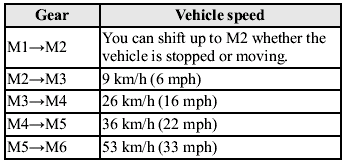
If the vehicle speed is lower than the speed specified for each gear, the gear cannot be shifted up to a higher gear.
Shifting down
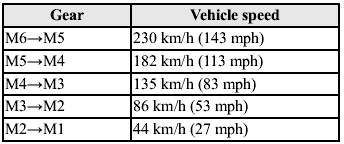
If the vehicle speed is higher than the speed specified for each gear, the gear cannot be shifted down to a lower gear.
During deceleration, the gears shift down automatically when speed is reduced to the following:
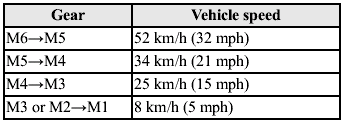
NOTE:
The gear does not shift down to M1
automatically while in the second gear fixed
mode.
If the vehicle is kicked down at the following speeds or lower, the gears shift down automatically:
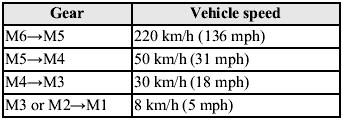
Recommendations for shifting
Upshifting
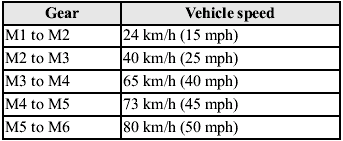
For normal acceleration and cruising, we recommend these shift points.
Downshifting
When you must slow down in heavy traffic or on a steep upgrade, downshift before the engine starts to overwork. This gives better acceleration when you need more speed.
On a steep downgrade, downshifting helps maintain safe speed and prolongs brake life.
Driving Tips
Passing
For extra power when passing another vehicle or climbing steep grades, depress the accelerator fully. The transaxle will shift to a lower gear, depending on vehicle speed.
Climbing steep grades from a stop
To climb a steep grade from a stopped
position:
1. Depress the brake pedal.
2. Shift to D or M1, depending on the load weight and grade steepness.
3. Release the brake pedal while gradually accelerating.
Descending steep grades
When descending a steep grade, shift to lower gears, depending on load weight and grade steepness. Descend slowly, using the brakes only occasionally to prevent them from overheating.
See also:
Moonroof
* Some models.
The moonroof can be opened or closed
electrically only when the ignition switch
is in the ON position.
WARNING.
Do not let passengers stand up or
extend part of their body throu ...
Scheduled Maintenance (Mexico)
Follow Schedule 1 if the vehicle is operated mainly where none of the
following conditions
apply.
- Repeated short-distance driving.
- Driving in dusty conditions.
- Driving with extended use of ...
In Case of an Emergency
Helpful information on what to do in an emergency. ...


